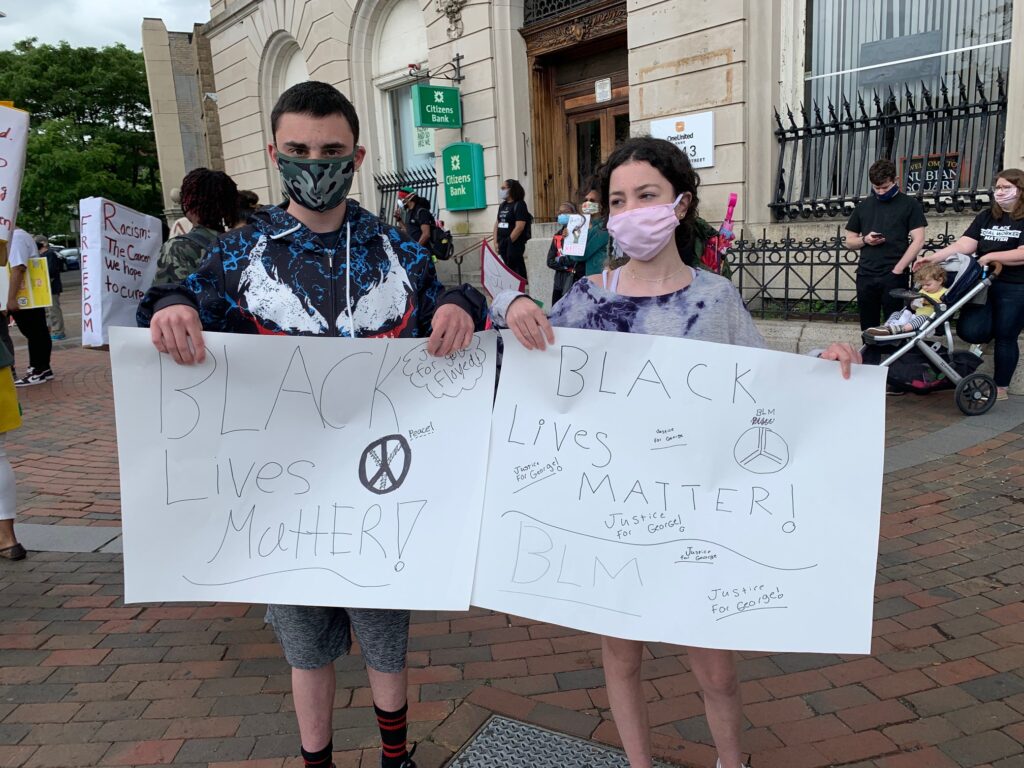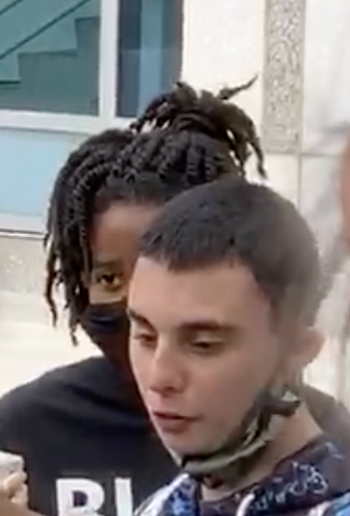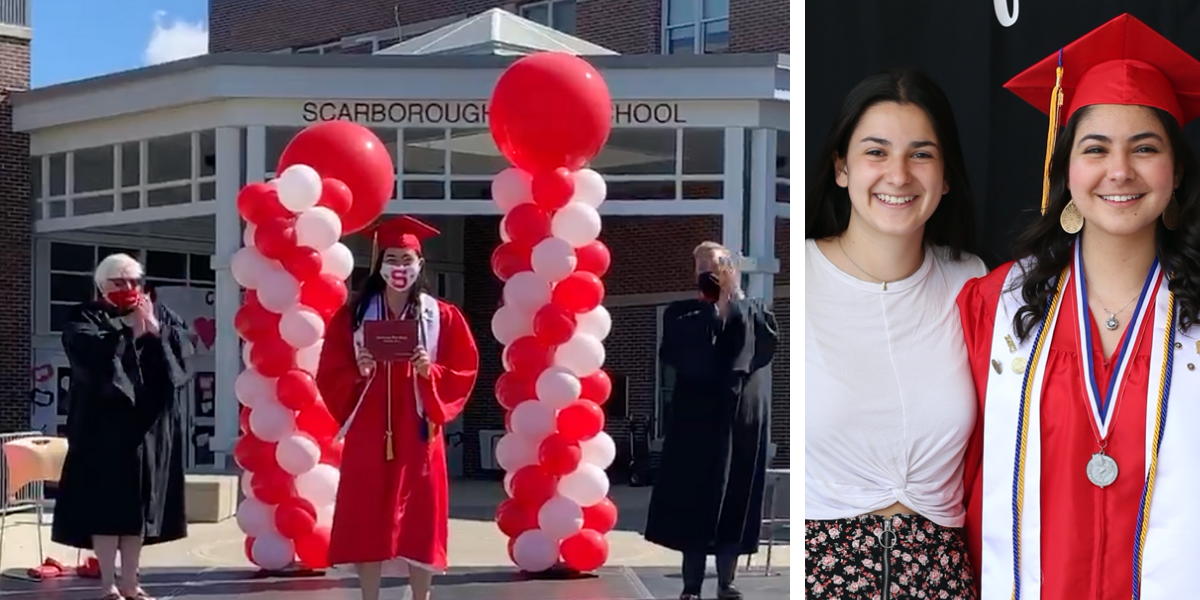We are very happy that you like sharing articles from the site. To send more articles to your friends please copy and paste the page address into a separate email.Thank You.
Printer-Friendly Version | Email Article

Teddy and Lyla Brooks at a Black Lives Matter rally
In my article each June I write a similar message, noting that this will be my last column until September. I also express my appreciation for the feedback, questions, and insights offered by my readers during the past year. I do so again in this column as I address two events that have dominated our world; one a deadly virus, the other the murder of George Floyd, a Black man, by a White police officer in Minneapolis.
(I wish to note that although there are different opinions about whether the words “black” and “white” should be capitalized when referring to racial groups, in keeping with guidelines proposed by the American Psychological Association they will be capitalized in this article.)
In my past three columns, I cited the devastating impact of COVID-19 on many aspects of our lives. As of this writing we have had, according to one report, nearly nine million confirmed cases of the virus and more than 460,000 deaths worldwide. The numbers continue to rise in many locations. Countless individuals and families have experienced significant disruptions occasioned by school and business closures, stay-at-home orders, childcare issues, layoffs, and furloughs. It is not surprising that since the coronavirus struck with unrelenting force in March, there has been a reported increase in levels of anxiety, depression, anger, and mental health struggles. Desperation is evident in the voices of those who are concerned about whether they will be able to pay the rent and have enough money to buy food for their family.
One of my objectives in writing articles and giving webinars since the outbreak of the coronavirus in the United States is to share ideas and strategies that I believe can help us to become more hopeful and resilient during these very challenging, upsetting times. I appreciate the fact that I have a platform to express my thoughts, but I must admit that at times I am concerned that my words might be misconstrued. As one example, when I propose ideas for coping with adversity and gaining what I have called “personal control” of our lives, I hope that my message is not interpreted to mean, “If you fail to successfully apply strategies to become resilient then you’re not trying hard enough or you’re not strong enough to overcome these stressful events.”
The reality is that given the extensive and ongoing burdens confronting many of our friends and neighbors, including those of racism and poverty, I fully recognize there are often many barriers to initiating change and to focus on what we have control over. For some, the process of managing stress and overcoming obstacles will require more time, effort, and support than for others. For the former, addressing problems represents a Herculean task with many additional hurdles that stand in their way.
A Murder in Minneapolis
In my May column, I described lessons learned from previous man-made and natural disasters that could be applied in our efforts to confront the coronavirus. As I noted in that column, my plan for this month was to detail firsthand accounts of individuals of different ages whose beliefs and subsequent actions strengthened their emotional and physical well-being and resilience. They displayed personal control by adopting a problem-solving attitude and by engaging in what I have called “contributory activities” through which they enriched the lives of others and in the process found greater purpose in their own lives.
I will still incorporate these themes in this article but also in the context of the murder of George Floyd on May 25, an impactful, transformative event that a number of people consider of equal if not greater significance than COVID-19. Video of the police officer pressing his knee on Floyd’s neck as the latter lay handcuffed in the street saying, “I can’t breathe,” and calling “Mama” for his deceased mother, was difficult to watch. The video quickly went viral, unleashing protests against racism and police brutality nationally and internationally.
One striking difference from past Black Lives Matter rallies and vigils, as observed by many Black clergy and leaders, was the noticeable presence of individuals of many different races. Some reported that these protests had a “different feel” from those in the past, and they voiced hope that progress could be made to address the legacy of racism upon which the United States and other countries was built.
Antiracism
Eradicating the systemic racism that plagues not only the United States but the world as well is a formidable challenge, requiring honest self-reflection and intentional action on all of our parts. It demands our becoming increasingly empathic in an attempt to understand the perceptions and experiences of others who are different from us in terms of such factors as their race, religion, backgrounds, and socioeconomic status. It requires an ongoing open and respectful dialogue among people that many of us realize will not be easy.
Ibram X. Kendi, as of July 1 to be the Founding Director of the Boston University Center for Antiracist Research and author of How to Be an Antiracist, was interviewed by Katrina Schwartz for an article posted on MindShift. In the interview Kendi observed that as he received treatment for stage 4 colon cancer a few years ago, “I couldn’t help noticing the commonalities between cancer and racism—they are both metastatic.”
Kendi stated, “It (racism) has literally spread to every part of our body politic,” adding that if one thinks of racism as a cancer, then the argument, “If we don’t talk about it, it will go away” seems ridiculous. Instead, Kendi argued that Americans must combat racism by becoming what he calls “antiracists,” defining the latter as, “Someone who is expressing an antiracist idea or supporting an antiracist policy with their actions. And I define an antiracist idea as any idea that says the racial groups are equal.” He cautioned that healing America of racism will not be free of pain, just as he fought his cancer despite feeling despair.
To Begin to Take Antiracist Actions

Teddy speaking at the rally
Teddy and Lyla, our two grandchildren who live a mile down the road from us in Needham, a suburb of Boston, were understandably very upset by the murder of Floyd. They participated in a Black Lives Matter rally in Roxbury, a neighborhood in Boston that houses a primarily Black and Hispanic population. Not only were Teddy and Lyla at the rally with our daughter-in-law Suzanne, but Teddy spoke at the rally, which I know took a great deal of courage on his part.
Marilyn and I were not aware until later that they were at a protest against racism and police brutality in Boston. That same afternoon we attended a Black Lives Matter vigil in Needham sponsored by the local clergy. Given the relatively short notice for the vigil I was impressed by the large turnout stretching many blocks on one of the main streets in our town. I was also impressed by the number of children with their parents and by the groups of middle and high school age teens who attended in small groups (I should note that it was also reassuring to see everyone wearing masks and practicing social distancing).
Attention has been directed towards removing symbols, statues, and monuments associated with the Confederacy and/or individuals who during their lives espoused racist ideas and engaged in racist activities, including slavery. I have heard some advance the argument that these people and practices are part of our history so why deny their existence? I don’t believe anyone is denying history by removing symbols of racism in our everyday lives, especially if we ensure that these historic figures and their practices are studied in our classrooms and different museum exhibits. We must learn from and not honor the hurts of the past in order to guide our actions in the present and future.
As just one illustration of antiracism in this kind of context, it is imperative that those of us who are White strive to understand how Bubba Wallace, the only Black racer in NASCAR’s top tier, felt when viewing the Confederate flag displayed at racetracks. Or to understand how any Black would feel attending a NASCAR race and seeing a symbol of the Confederacy and slavery at the event. As Wallace explained in an interview prior to NASCAR banning the Confederate flag at its events, “No one should feel uncomfortable when they come to a NASCAR race. It starts with the Confederate flags. Get them out of here. There is no place for them. There’s going to be a lot of angry people who carry those flags proudly, but it’s time for a change. We have to change that, and I encourage NASCAR to have those conversations.”
As Wallace predicted, there are those who are very upset by NASCAR’s decision to ban the Confederate flag at their races. I think it was the morally correct action to take, an action that was supported by many of NASCAR’s top stars, including racing icon Jimmie Johnson who said, “I support Bubba Wallace and NASCAR that the Confederate flag should not be up at our events.”
Johnson, Wallace, and other drivers adhered to their stated values when they severed ties with a racing helmet designer after that company reacted to NASCAR’s decision by calling Wallace’s car with the words “Black Lives Matter” on it as “garbage.”
And sadly, just as I was finishing this article, I read a news report of a noose found in Wallace’s garage stall at Sunday’s NASCAR race at Talladega, Alabama. NASCAR strongly condemned the action and Wallace said, “This will not break me. I will not give in nor will I back down. I will continue to proudly stand for what I believe in.” Wallace also emphasized the support he has received among his fellow drivers.
“Black Lives Matter”
Some have questioned the use of the words “Black Lives Matter,” especially countering with the statement that “All Lives Matter.” They ask, “What’s the purpose of singling out one group in terms of lives being important?” My son Rich read and reposted on his Facebook page a statement that he read on Michael Wayne’s Facebook page. I believe the statement helps to explain the importance of using the words “Black Lives Matter” without diminishing in any manner “All Lives.” It read:
For my all lives matter folks: When the Boston marathon was bombed everybody’s profile picture went “Boston strong” nobody said “all cities are strong”!
When the Las Vegas shooting happened people changed their profiles “stand with Vegas” nobody said “well what about the people that got shot in my city”!
Have you ever seen someone counter a “breast cancer” post with what about colon cancer”?
But for some reason if someone says “black lives matter” it turns into all inclusive “all lives matter.”
It’s not an either/or proclamation. When there is a crisis we have always rallied around that particular group. It doesn’t discredit or diminish any other group. It just brings awareness and support to the group that needs attention.
Rich continued his reflections about Black Lives Matter in a special episode of his weekly Agents of Change podcast, which typically focuses on social media and digital advertising and marketing themes. It’s a briefer episode than his others and I believe in a little less than 9 minutes Rich raises questions that all of us should be considering. Here is a link to that podcast.
Dual Issues that Are Intertwined
The ramifications of COVID-19 and the murder of George Floyd and racism are intertwined in several ways, including when one considers the high percentage of Blacks and Hispanics who have been infected by and died from the virus. The two events also invite several similar strategies to meet these challenges, including adopting an attitude of personal control and examining what each of us can do to improve our world during these difficult times. To move ahead with both challenges, we must nurture empathy, understanding, and positive connections with others. Such connections are a basic scaffolding for resilience to develop. In addition, I have often noted that resilience is reinforced when we find purpose in our lives and when we engage in activities that enrich the lives of others.
In whatever ways we can, through whatever platforms we have available, we must as Kendi advocated, become antiracists and actively and intentionally address the daunting problems of COVID-19 and racism. To simply be a supportive spectator is not enough. And let us remember that when we take action and involve our children as well, we will be promoting a sense of purpose, caring, and resilience—attributes that will last a lifetime.
A Few Additional Comments
I want to once again thank all of those who have been on the front-line since the coronavirus began, those essential workers in many different fields whose responsibilities helped all of us to deal more effectively with COVID-19.
Although I will not be sending out another column until September, I plan to continue to provide links to articles that I have found helpful during these times. I will post the links via my social media platforms, including Facebook, Twitter, and LinkedIn. In addition, I will be posting links to webinars and interviews I have conducted on the Video Clips page of my website and on my YouTube Channel. All of these platforms are easily accessible through my website.
And finally, I want to offer congratulations to the class of 2020, which includes my granddaughter Maya who graduated from Scarborough, ME High School a few weeks ago. I know this year’s seniors have been very disappointed about missing out on many traditional senior events, whether in high school or college. I hope your future years are filled with happiness and success, and at some point you will show photos and stories from this time to your children and grandchildren and describe how you and your classmates coped with the pandemic and other challenges of 2020.

Maya Brooks receiving her diploma Maya celebrating with her sister Sophie



